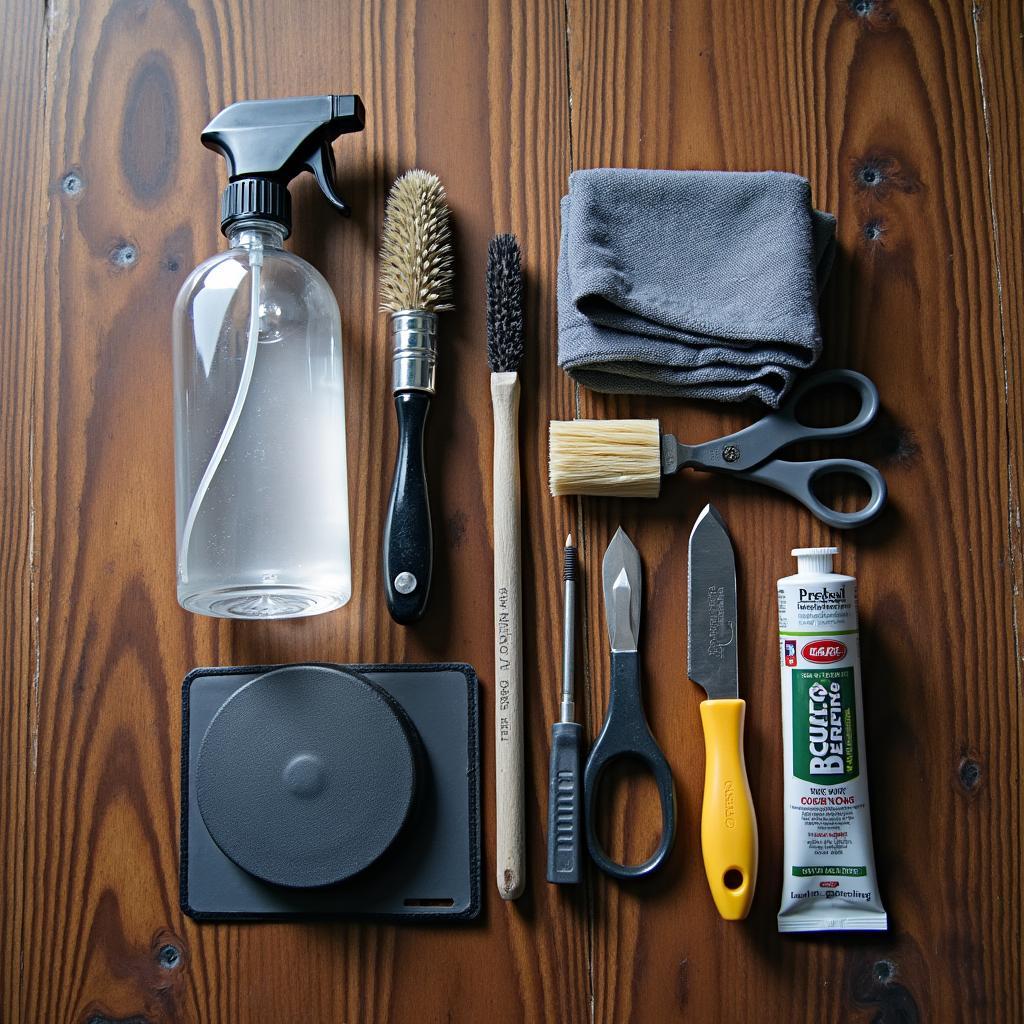Worn, torn, or stained car seats got you down? Before you shell out big bucks for a professional, learn how to repair upholstered car seats yourself. With a few simple tools and techniques, you can breathe new life into your vehicle’s interior and save a bundle in the process.
Identifying the Damage: What Needs Fixing?
Before diving into the repair, it’s crucial to assess the damage. Is it a minor cigarette burn, a stubborn stain, a gaping tear, or faded and cracked leather? Each issue requires a different approach and specific repair materials.
“Knowing your enemy is half the battle,” says John Smith, a veteran auto upholsterer with over 20 years of experience. “A proper diagnosis of the damage will dictate the right repair method and ensure the best possible outcome.”
Essential Tools and Materials for Upholstery Repair
Having the right tools is crucial for successful car seat upholstery repair. Here’s a basic kit to get you started:
- Cleaning Supplies: A gentle upholstery cleaner, microfiber cloths, and a soft-bristled brush are essential for prepping the area before repair.
- Repair Kits: Choose a kit specific to the type of damage and your upholstery material. Leather repair kits differ from fabric ones.
- Scissors and Utility Knife: Useful for trimming loose threads and cutting repair patches.
- Adhesives: Fabric glue or leather adhesive, depending on your upholstery, will secure patches and mend tears.
- Applicators: Spatulas, cotton swabs, and toothpicks help with precise application of adhesives and fillers.
- Color Matching: For leather, you’ll likely need a leather dye to match the repaired area to the original color.
Step-by-Step Guide to Repairing Common Upholstery Issues
Now, let’s tackle those common car seat woes with practical, easy-to-follow steps:
1. How to Repair a Burn Hole in Upholstered Car Seat
- Clean the Area: Gently clean the burned area with a damp cloth and mild upholstery cleaner. Allow it to dry completely.
- Apply Filler: If the burn has created a hole, use a fabric or leather filler to fill it in, building it up slightly higher than the surrounding surface. Let it dry completely.
- Sand and Blend: Once dry, gently sand the filler to create a smooth, even surface.
- Apply Colorant: If necessary, apply a matching fabric paint or leather dye to the repaired area. Use a thin coat and build up the color gradually.
Can cigarette burns be repaired on car seats? Absolutely! This method works wonders for small burn holes.
2. Can You Repair Tears in Leather Car Seats?
Tears in leather seats require a slightly different approach:
- Clean and Prepare: Clean the torn area with a leather cleaner and let it dry completely.
- Support the Tear: If possible, use a piece of tape or masking tape on the backside of the tear to bring the edges together.
- Apply Leather Adhesive: Apply leather adhesive to the back of the tear or use a leather repair kit that includes a backing patch.
- Press and Hold: Press the edges of the tear together firmly and hold for the time specified on the adhesive instructions.
For larger tears or extensive damage, it’s best to seek professional help or consider [leather car seat repairs near me](https://carrepairon.com/leather-car seat-repairs-near-me/).
3. How to Repair a Tear in Fabric Car Seat
- Trim Loose Threads: Use scissors to carefully trim any loose threads around the tear.
- Apply Fabric Glue: Apply fabric glue to the edges of the tear and any backing patch if using one.
- Join the Edges: Carefully align the edges of the tear and press firmly together. Use clamps or weights to hold the repair in place while the glue dries.
Remember to choose a strong fabric glue suitable for upholstery and the weight of the fabric.
Maintaining Your Repaired Upholstery: Tips for Long-Lasting Results
Once you’ve successfully repaired your car seats, proper maintenance is key to keeping them looking their best:
- Regular Cleaning: Vacuum and clean your car’s interior regularly to prevent dirt and grime buildup.
- Use Seat Covers: Consider using seat covers to protect your upholstery from spills, stains, and wear and tear.
- Address Spills Immediately: Blot spills immediately to prevent them from setting into the fabric or leather.
- Condition Leather Seats: Regularly condition your leather seats to keep them soft, supple, and prevent cracking.
Conclusion: DIY Car Seat Upholstery Repair – A Rewarding Endeavor
Repairing your upholstered car seats can be a satisfying and cost-effective way to refresh your vehicle’s interior. With a little patience, the right tools, and some DIY spirit, you can tackle common upholstery problems and restore your car seats to their former glory.



